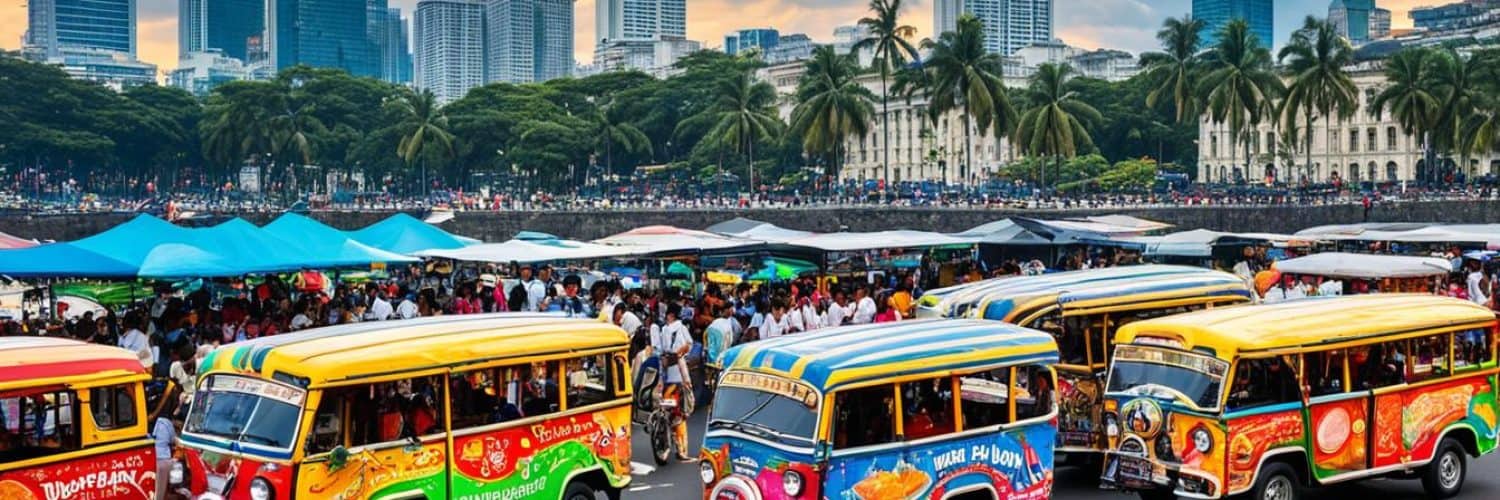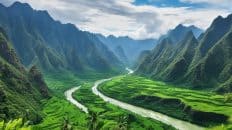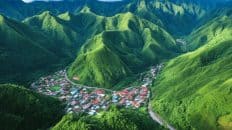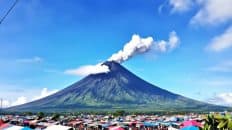Nestled in the archipelagic splendor of the Philippines, Manila stands proudly as the nation’s capital. This bustling metropolis serves as more than just a political hub; it is a vibrant tapestry weaving together the economic, social, and cultural threads that define the Filipino spirit. Manila offers a unique experience that leaves an indelible mark on every visitor. In this exploration of Manila, we will delve into the various facets that make this city a cornerstone of the Philippines.
Key Takeaways:
- Manila is the capital city of the Philippines
- It is a vibrant metropolis with a rich cultural heritage
- Manila offers a unique blend of history, attractions, and vibrant nightlife
- The city is known for its diverse culinary scene and bustling markets
- Exploring Manila’s districts allows visitors to experience different facets of the city
Manila’s Storied History
Manila’s story is a fascinating chronicle of resilience and transformation, from a modest settlement to a bustling metropolis. The city’s narrative is rich with layers of history, from the pre-colonial era to the Spanish colonization that established Manila as the capital of the Spanish East Indies. The Spanish colonization brought with it a lasting impact on Manila’s culture, architecture, and language.
During the American occupation, which followed the Spanish-American War, Manila experienced significant changes. The Americans introduced new architectural styles, educational reforms, and administrative systems that shaped the city’s development.
The American occupation brought about a period of modernization and urban planning in Manila. The city’s infrastructure was enhanced, and educational institutions were established, laying the foundation for progress and development.
However, Manila’s progress was halted by the events of World War II. The city bore witness to intense battles and suffered widespread destruction. Many historical buildings were reduced to rubble, leaving behind a battered cityscape.
| Historical Period | Key Events |
|---|---|
| Pre-colonial era | Manila as a trading hub and cultural center |
| Spanish colonization | Establishment of Manila as the capital of the Spanish East Indies |
| American occupation | Introduction of architectural styles and educational reforms |
| World War II | Destruction of Manila and subsequent rebuilding |
Today, Manila stands as a testament to its storied past, a city that has risen from the ashes of war and continues to thrive. The remnants of its colonial past can be seen in the architecture of Intramuros, the historic walled city, while the modern skyscrapers stand as symbols of progress and resilience.
Manila’s Geographical Splendor
Manila’s geography is a tapestry of contrasts, showcasing the stunning natural features that define the city. Overlooking Manila Bay and nestled amidst the picturesque Sierra Madre mountain range, Manila offers a unique blend of urban and natural beauty.
Manila Bay: A Coastal Paradise
The breathtaking Manila Bay is a prominent feature of the city’s landscape. With its azure waters and golden sunsets, it creates a captivating backdrop for Manila’s bustling metropolis. The bay serves as both a scenic attraction and a bustling port, connecting Manila to the rest of the world.
The Majestic Pasig River
The Pasig River runs through the heart of Manila, dividing the city into its northern and southern halves. This historic waterway has played a significant role in shaping the city’s identity and economic development. While once a vital water transportation route, the Pasig River now offers a picturesque setting for leisurely boat cruises and riverside walks.
The Splendor of Sierra Madre
The grandeur of the Sierra Madre mountain range looms over Manila, providing a stunning natural backdrop. The majestic peaks and lush greenery of this mountain range offer a tranquil escape from the city’s hustle and bustle. Adventurers and nature enthusiasts can explore the Sierra Madre’s vast hiking trails and immerse themselves in its breathtaking beauty.
Manila’s geography, with its proximity to Manila Bay, the Pasig River, and the Sierra Madre mountain range, shapes the city’s landscapes and contributes to its unique charm. The tropical climate, characterized by wet and dry seasons, further enhances the varied habitats and vibrant ecosystems found within the city limits.
Manila’s Economic Vitality
Manila, the capital city of the Philippines, pulsates with economic vitality, serving as a bustling hub of diverse industries. From vibrant manufacturing sectors to thriving service-based businesses, Manila’s economy is a dynamic force driving the nation’s progress.
The city’s strategic location and well-developed infrastructure make it a prime trade center, connecting the Philippines to the global market. Manila’s ports serve as vital gateways for imports and exports, facilitating the flow of goods and fostering international trade relationships.
However, Manila’s economic growth is not without its challenges. Rapid urbanization has led to issues such as pollution, traffic congestion, and overpopulation, necessitating sustainable urban planning and policy interventions to ensure the city’s long-term prosperity.
In the face of these challenges, Manila continues to adapt and innovate, embracing new technologies and fostering entrepreneurship. The city’s resilient spirit and determination contribute to its economic resilience and viability.
| Key Industries in Manila | Contributions to Manila’s Economy |
|---|---|
| Manufacturing | Contributes significantly to employment and export revenue |
| Services | Includes sectors such as finance, information technology, tourism, and business process outsourcing (BPO) |
| Construction | Driven by ongoing urban development and infrastructure projects |
| Retail and Wholesale Trade | Thriving marketplaces supporting local and international businesses |
| Tourism and Hospitality | Generates revenue from domestic and international visitors |
Investment Opportunities in Manila
With its economic vibrancy, Manila offers a range of investment opportunities for local and international businesses. The city’s favorable business climate, skilled workforce, and strategic location make it an attractive destination for investors.
The manufacturing sector presents opportunities for businesses looking to take advantage of Manila’s skilled workforce and competitive costs. Industries such as electronics, textiles, and food processing have thrived in Manila, benefiting from the city’s strategic location and favorable trade conditions.
The services sector, particularly the BPO industry, continues to grow in Manila. With a large pool of English-speaking talent, Manila has become a preferred outsourcing destination for various business processes, including customer support, IT services, and back-office operations.
Moreover, Manila’s booming tourism industry offers investment opportunities in hotels, resorts, and hospitality services, catering to both domestic and international tourists seeking unique experiences in the city.
“Manila’s economic vitality is fueled by its diverse industries and its position as a key trade center in the Philippines. As the city continues to grow, sustainable development and policies will be crucial to overcoming challenges and fostering long-term economic prosperity.”
Manila’s economic vitality fuels the nation’s progress and underpins its status as a thriving trade center. As the city embraces innovation and urban planning, it sets the stage for continued economic growth and development.
Manila’s Vibrant Nightlife
When the sun sets in Manila, the city comes alive with a pulsating energy that sets the stage for an unforgettable night out. From the bustling streets of Malate to the upscale district of Makati, Manila offers a diverse array of nightlife venues that cater to every taste and preference.
For music lovers, Manila boasts a thriving live music scene that showcases local talent and international acts. Whether you’re a fan of jazz, rock, or electronic music, you’ll find music venues that will keep you entertained all night long. Revel in the soulful melodies at the famous 19 East in Sucat, where you can enjoy live performances in an intimate setting.
Looking for a night of dancing and revelry? Manila’s nightclubs are renowned for their energetic atmosphere and top-notch DJs. Visit The Palace in Taguig, a sprawling entertainment complex that features multiple clubs and bars, or party the night away at Valkyrie in Makati, a popular hotspot known for its vibrant ambiance and celebrity sightings.
Manila’s nightlife is not just limited to music venues and nightclubs; the city also offers a wide range of entertainment options for those looking for a unique experience. Dive into the world of interactive virtual reality gaming at Virtual PH in Quezon City, where you can immerse yourself in thrilling adventures and compete with friends.
“The nightlife in Manila is unlike anything else. From the lively music venues to the pulsating nightclubs, there’s always something happening. It’s a city that never sleeps.” – Carlos, a local resident.
With its vibrant nightlife, Manila guarantees an unforgettable experience for locals and tourists alike. So, put on your dancing shoes, grab a drink, and let Manila’s nightlife sweep you off your feet.
Exploring Manila’s Districts
Manila is a city of vibrant diversity, offering a unique tapestry of districts, each with its own fascinating history, distinct culture, and delectable cuisine. From the remarkable Chinatown of Binondo to the iconic walled city of Intramuros, Manila’s districts provide a plethora of experiences to indulge in. Whether you’re a history buff, a shopaholic, or a food lover, there’s something for everyone to discover in Manila’s diverse neighborhoods.
Binondo: The Oldest Chinatown in the World
Step into the enchanting streets of Binondo and immerse yourself in a vibrant fusion of Filipino and Chinese cultures. Explore the bustling markets, visit ornate temples, and savor delectable Chinese dishes at the local eateries. Binondo is a true testament to the enduring spirit of the Filipino-Chinese community.
Intramuros: The Historic District
Transport yourself to the past as you wander through the stone walls of Intramuros. This historic district holds the remnants of Spanish colonial architecture, centuries-old churches, and charming cobblestone streets. Uncover Manila’s colonial history through museums, historic sites, and horse-drawn carriage rides.
Malate: Where the Arts and Culture Flourish
Known for its vibrant nightlife and thriving arts scene, Malate is a creative haven in Manila. Discover art galleries, theater performances, and hip bars. Dive into the local music scene, with live performances by talented Filipino artists bringing the streets to life.
Quiapo: A Tapestry of Faith and Culture
Quiapo is a district that pulsates with religious fervor, cultural traditions, and street markets. Visit the Quiapo Church, home to the revered Black Nazarene, and experience the vibrant atmosphere of the Feast of the Black Nazarene. Explore the bustling streets, filled with stalls selling religious artifacts and local handicrafts.
Santa Cruz: The Heart of Manila’s Commerce
Santa Cruz is a bustling commercial hub where shoppers can find everything from traditional Filipino goods to modern fashion trends. Navigate through the vibrant street markets and shopping centers, and discover unique finds at bargain prices. This district truly embodies the vibrant pulse of Manila’s commerce.
Tondo: A Glimpse into Urban Life
Tondo provides a raw and authentic experience of Manila’s urban life. This district is home to a tight-knit community, bustling markets, and humble neighborhoods. Immerse yourself in the lively street life, taste local street food, and witness the resilience of its vibrant residents.
University Belt: Knowledge and Learning Hub
The University Belt is a vibrant educational hub, housing prestigious universities and colleges. This district buzzes with the energy of eager learners, vibrant campus life, and countless food spots catering to students’ tastes. Take a walk along the tree-lined streets and feel the youthful pulse of knowledge flowing through the air.
Southeast Suburbs: Nature and Tranquility
Escape the hustle and bustle of the city center and venture into Manila’s Southeast Suburbs. Explore parks, gardens, and tranquil landscapes that provide a breath of fresh air. Whether you’re strolling through Rizal Park or immersing yourself in the biodiversity of Manila Ocean Park, the Southeast Suburbs offer a peaceful retreat.
Embark on a journey through Manila’s diverse districts and unlock the captivating stories they hold. From the oldest Chinatown in the world to the historic charm of Intramuros, each district offers a unique glimpse into the soul of the city. Immerse yourself in the vibrant culture, indulge in culinary delights, and create unforgettable memories as you explore the heart of Manila.
Manila’s Cultural Heritage
Manila, the cultural center of the Philippines, is a treasure trove of cultural experiences that reflect the rich heritage of the city. Through its museums and cultural performances, visitors can immerse themselves in the vibrant Manila culture and witness the artistic expressions that define the Filipino spirit.
One of Manila’s cultural highlights is the Intramuros, where Spanish colonial attractions transport you back in time. From the iconic Fort Santiago to the majestic San Agustin Church, the remnants of Manila’s colonial past stand as a testament to its historical significance.
The Cultural Center of the Philippines, with its modernist architecture, is another remarkable symbol of Manila’s cultural heritage. This iconic venue showcases various art forms, including theater, dance, and visual arts, providing a platform for local talents to shine.
Manila’s Museums
Manila’s museums offer a deeper understanding of the city’s cultural heritage. The National Museum of the Philippines is a must-visit destination, housing extensive collections that encompass archaeology, anthropology, natural history, and fine arts. One of its highlights is the National Museum of Anthropology, which explores the diversity of Filipino culture through its exhibits.
For a unique museum experience, the Ayala Museum in Makati provides a glimpse into the art, history, and culture of the Philippines. Its interactive displays and immersive exhibitions offer an engaging and educational journey through Manila’s cultural tapestry.
Cultural Performances
In addition to museums, Manila’s cultural scene is brought to life through captivating performances. The CCP Complex, located near Manila Bay, serves as a hub for artistic spectacles. The Tanghalang Nicanor Abelardo and Tanghalang Francisco Balagtas showcase world-class theater productions, while the Tanghalang Aurelio Tolentino hosts dance performances that showcase the diverse traditions of the Philippines.
Manila’s cultural heritage is a testament to the resilience and creativity of the Filipino people. Through museums and cultural performances, visitors can engage with the city’s history, traditions, and artistic expressions, creating lasting memories.
Manila’s Cultural Highlights
| Cultural Attractions | Description |
|---|---|
| Intramuros | The historic walled city that preserves Manila’s Spanish colonial heritage, featuring attractions such as Fort Santiago and San Agustin Church. |
| Cultural Center of the Philippines | An architectural masterpiece that serves as a venue for various artistic performances and exhibitions, showcasing the contemporary cultural scene of Manila. |
| National Museum of the Philippines | A comprehensive museum complex that offers insights into the country’s archaeology, anthropology, natural history, and fine arts. |
| Ayala Museum | A museum in Makati that celebrates Philippine art, history, and culture through immersive exhibits and interactive displays. |
| CCP Complex | A vibrant cultural hub that hosts theatrical performances, dance shows, and music concerts, showcasing the diversity of Filipino artistic expressions. |
Hidden Gems in Manila
Beyond the well-known attractions, Manila is home to hidden gems that offer unique experiences. These lesser-known treasures showcase the charm and diversity of this vibrant city. From colonial churches to the Manila Chinese Cemetery and the delightful culinary delights of Binondo, Manila’s hidden gems are waiting to be discovered.
Colonial Churches
Manila is dotted with colonial churches that serve as both religious landmarks and architectural marvels. These centuries-old structures provide a glimpse into the Philippines’ history and religious heritage. From the iconic San Agustin Church in Intramuros to the historic Manila Cathedral in Plaza de Roma, exploring these colonial churches is a must for history buffs and architecture enthusiasts alike.
Manila Chinese Cemetery
Step into the intricate mausoleums of the Manila Chinese Cemetery and uncover the rich cultural heritage of Manila’s Chinese community. This 54-acre cemetery is a testament to the contributions and traditions of the Chinese immigrants who played a significant role in shaping Manila’s history. Walk through ornate mausoleums adorned with beautiful carvings and learn about the stories behind the resting places of prominent Chinese families.
Binondo Food
Delight your taste buds with a culinary adventure in Binondo, the oldest Chinatown in the world. Known for its vibrant street food scene, Binondo offers a wide array of delectable dishes that showcase the fusion of Chinese and Filipino flavors. From savoring mouthwatering noodles and sumptuous dumplings to indulging in traditional Chinese delicacies, Binondo is a paradise for food lovers seeking an authentic gastronomic experience.
Discover the hidden gems of Manila and unlock a side of the city that is often overlooked. Whether you’re exploring colonial churches, paying homage to the past at the Manila Chinese Cemetery, or indulging in the flavors of Binondo, these hidden gems will leave you with unforgettable memories of Manila’s charm and allure.
Conclusion
Manila, the vibrant capital city of the Philippines, is a testament to the country’s rich cultural diversity and historical significance. Its unique blend of the past and present creates a captivating tapestry of experiences for visitors to explore. Whether you’re delving into its storied history or immersing yourself in its vibrant nightlife, Manila offers something for everyone.
From the moment you arrive in Manila, you’ll be greeted with a vibrant energy that permeates the city. Its bustling streets, lively markets, and warm-hearted people reflect the dynamic spirit of the Philippines. As you navigate through the various districts, such as the historic Intramuros or the bustling Binondo, you’ll witness the cultural melting pot that Manila proudly embodies.
But Manila is more than just a cultural hub. It is a city with deep historical roots, having witnessed the rise and fall of empires, the struggles and triumphs of its people. Exploring landmarks like the colonial churches or the Manila Chinese Cemetery allows you to connect with the city’s past, gaining a deeper appreciation for its historical significance.
So, pack your bags and get ready to embark on a journey of discovery in Manila, where every moment is infused with vibrant life and tales waiting to be told. Experience the warmth of the Filipino people, indulge in the flavors of Manila’s culinary delights, and immerse yourself in the rich tapestry of cultures that make this city so extraordinary. Manila is calling, are you ready to answer?
FAQ
What are some attractions to visit in Manila?
There are several attractions to visit in Manila, including Intramuros, Rizal Park, Manila Ocean Park, and the National Museum of the Philippines.
Where can I find the best hotels and restaurants in Manila?
What is the best way to explore Manila’s cultural scene?
To explore Manila’s cultural scene, you can visit the Cultural Center of the Philippines, the National Museum, and the Ayala Museum. Additionally, attending cultural performances and festivals is a great way to immerse yourself in Manila’s vibrant culture.
Are there any hidden gems in Manila that are worth exploring?
Yes, Manila is home to several hidden gems that offer unique experiences. Some hidden gems worth exploring include the San Agustin Church, the Manila Chinese Cemetery, and the food haven of Binondo.
What are some popular nightlife spots in Manila?
Manila has a vibrant nightlife scene with a variety of music venues and nightclubs. Some popular nightlife spots include The Palace in Bonifacio Global City, Black Market in Makati, and Chaos Nightclub in City of Dreams.
How can I get around Manila?
Manila has various transportation options, including taxis, ride-hailing services, jeepneys, and the MRT and LRT train systems. It is advisable to plan your routes ahead of time and consider traffic conditions.
What is the best time to visit Manila?
The best time to visit Manila is during the dry season, which is from November to April. This is when the weather is more favorable for outdoor activities and exploring the city.
Is Manila a safe city for tourists?
Like any other major city, it is always important to take precautions and be aware of your surroundings. Overall, Manila is a safe city for tourists, but it is advisable to stay in well-populated areas and avoid displaying valuable items.
Are there any unique cultural experiences in Manila?
Yes, Manila offers unique cultural experiences such as attending traditional Filipino cultural performances, exploring the vibrant street art scene in Bonifacio Global City, and participating in the annual Pahiyas Festival in Lucban, which celebrates bountiful harvests.


















Add comment